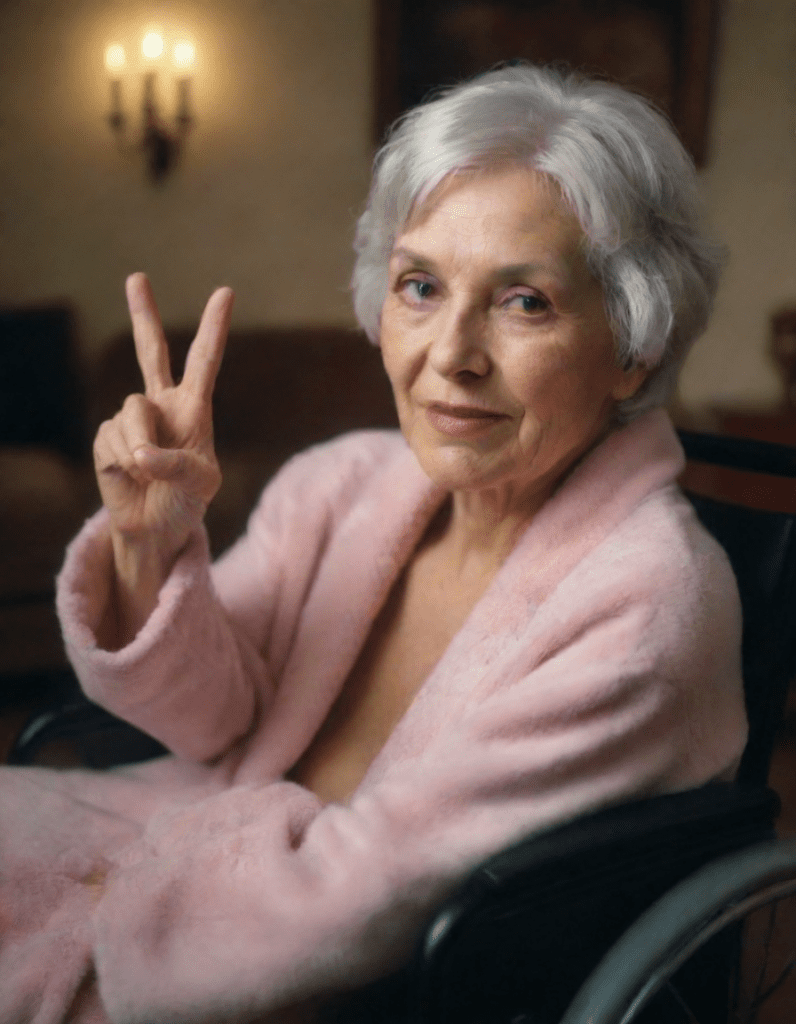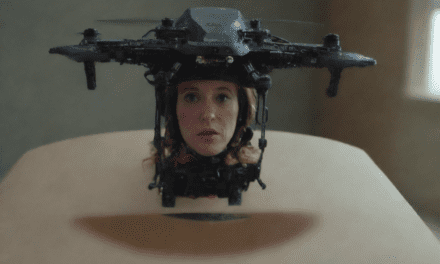Sunridge Pines Retirement Village had always been a peaceful, respectable place where elderly residents could live out their golden years in comfort. The halls were usually filled with the soft hum of wheelchairs, the shuffle of slippers, and the occasional lively round of bingo. But all of that changed one fateful Tuesday morning when Ethel McGillicuddy, a sprightly 89-year-old, inadvertently started a fashion revolution—though no one, including Ethel, quite knew it at the time.

It all began with a simple wardrobe malfunction. Ethel, who had never been one to pay much attention to the details of her clothing, accidentally put on a blouse that was two sizes too small. Not that it mattered much to her—Ethel had never been one to follow fashion trends. She was more concerned with comfort than style. But as she meandered into the dining hall that morning, her blouse gaped open in a most unexpected way. The top button had come undone, and, to the horror of the staff and the amusement of her fellow residents, Ethel’s left breast was fully exposed.
“Oh dear,” she muttered, giving it a half-hearted tug but not bothering to fix it entirely. She took her seat, unaware that her simple act of indifference would soon give birth to the legend of the “Oops Grannies.” She did notice one man staring, and she quickly gave him the peace sign with her hand. This has become the symbol for the ladies. They give the peace sign so people in the know will not think they are really unknowingly exposed.
By lunch, the entire facility was buzzing. The staff was in disarray. Ethel’s accidental exposure had stirred up a whole lot more than the soup of the day. Harold, a retired high school teacher known for his stern lectures and stoic demeanor, nearly choked on his sandwich at the sight. Clarence, who hadn’t had a coherent conversation with Ethel in months, suddenly found himself offering her some of his dessert, his eyes lingering a bit longer than usual. But it wasn’t just the men who took notice—Phyllis, Gertrude, and Mildred all exchanged knowing glances.
“Well, if she can get away with it, why shouldn’t we?” Phyllis declared at their knitting circle that afternoon.
“It’s not like anyone’s paying attention to us otherwise,” Gertie added with a wink.
The next morning, Phyllis made her move. She came to breakfast wearing her usual pink cardigan, but this time with just enough “oops” that the buttons didn’t quite align. Her blouse shifted precariously, revealing a little more than the casual viewer might expect. When a flustered nurse ran over to adjust it, Phyllis simply smiled and said, “Oops, I didn’t notice.”
The trend quickly caught on. Within a week, Sunridge Pines had become ground zero for the fashion faux pas that would soon sweep nursing homes across the country. The “Oops Grannies” had arrived.
Unlike typical fashion trends, this one wasn’t about carefully curated outfits or strategic cutouts. The “Oops Grannies” had mastered the art of accidental exposure—whether it was a blouse that was mysteriously missing a few buttons or a shawl that constantly slipped off the shoulder just enough to reveal something it shouldn’t. And that was the brilliance of it. No one could accuse them of intentional indecency. Every time someone pointed out the mishap, the response was always the same: “Oops!”
But for the staff, it was becoming an absolute nightmare.
“It’s like trying to wrangle a herd of toddlers with malfunctioning clothes,” muttered Dolores, the exasperated director of Sunridge Pines. “Every time I turn around, someone’s got a boob out! And they keep pretending like they don’t know what’s happening.”
Staff meetings were now dominated by discussions on how to handle the new fashion disaster. “We’ve got to maintain some level of decorum,” Dolores continued, nervously straightening her own blouse. “This is still a professional facility. We can’t have wandering breasts at every meal!”

The nurses and aides tried their best to gently remind the Oops Grannies to cover up. But each time they fixed a blouse or pulled up a shawl, it seemed to slip back into “oops” territory within minutes. It was as if the universe itself was conspiring to keep the Oops Grannies uncovered, much to the ongoing frustration of the staff.
Visitors, too, were caught in the crossfire. Todd, Ethel’s long-suffering son, came to visit one Sunday and was immediately greeted by his mother’s casual wardrobe malfunction.
“Mom!” he yelped, his face flushing beet red. “You can’t just… you’ve got to cover up! People can see!”
Ethel, ever the nonchalant matriarch, simply shrugged. “Oops! Must have slipped. Can you help me with that, dear?”
Todd fumbled with the buttons, but just as he fastened one side of her blouse, the other side slipped down, revealing even more than before. By the time he managed to button her up completely, she’d managed to unbutton herself again while reaching for a cup of tea.
It wasn’t just Ethel, either. Gertie had perfected the art of the “delayed oops,” where her blouse seemed perfectly fine until she stood up or bent over slightly, at which point gravity did the rest. Phyllis was known for “forgetting” her shawl entirely, leaving it draped over her chair as she went about her day, blissfully unaware (or so she claimed) of the spectacle she was creating.
“It’s like some kind of covert rebellion,” Todd complained to the other visitors during a particularly chaotic family day, as he dodged multiple exposed chests while trying to chat with his mother.
Some of the younger visitors, especially the grandchildren, found the whole thing wildly entertaining. “Granny’s on a whole other level,” laughed one teenage boy who had come to visit his grandmother, Mildred. “She’s more savage than I am.”
It wasn’t long before the Oops Grannies started attracting attention from beyond the nursing home. A visitor had snapped a photo of the knitting circle in full “oops” mode—Ethel’s blouse slipping dangerously low, Gertie’s cardigan hanging half off her shoulder, and Phyllis in the background, seemingly unaware that her top had migrated north, leaving her southern hemisphere fully exposed. The photo went viral on social media with the caption, “Oops Grannies don’t care, and neither should you!”
The hashtag #OopsGrannies exploded overnight. Suddenly, nursing homes across the country were dealing with their own outbreaks of accidental exposures. What had started as a small rebellion against the confines of old age had turned into a national phenomenon.
Some fashion magazines even tried to capitalize on the trend. “Carefree Confidence: How the Oops Grannies Are Redefining Fashion in Their Twilight Years,” read one article, complete with photos of stylish young models attempting to recreate the haphazard wardrobe malfunctions of their elderly counterparts. But the essence of the trend—true accidental exposure—couldn’t be replicated in a glossy spread. It was something only the Oops Grannies themselves had mastered.
Back at Sunridge Pines, Dolores was losing sleep. She had hired extra staff just to keep up with the constant need to adjust clothing. “We’ve got to find a solution,” she muttered to her assistant during one particularly chaotic morning. “If this keeps up, we’ll have to start sewing the clothes directly onto them!”
But no matter how hard the staff tried, the Oops Grannies always found a way to let their fashion faux pas shine. Whether it was a slip of the sleeve or a mysteriously unbuttoned blouse, their “oops” moments seemed to multiply by the day.
The male residents, meanwhile, were delighted by the turn of events. Harold, who had always been a model of restraint, found himself offering to assist the ladies whenever their clothing needed a bit of adjustment. Clarence, ever the opportunist, began strategically positioning himself at breakfast so he could catch the inevitable “oops” in action.
“They’ve never been so lively,” observed one of the nurses, as she watched Harold practically leap from his seat to help Gertie with her cardigan. “It’s like they’re teenagers again.”

Despite the chaos, the Oops Grannies were having the time of their lives. For years, they had been sidelined, expected to fade quietly into the background. Now, they were front and center—unintentionally (or so they claimed) making waves in their nursing home and beyond. Their carefree attitude and casual disregard for social norms were a breath of fresh air in a world that often treated the elderly as invisible.
And so, the Oops Grannies continued their reign at Sunridge Pines. They were a constant source of frustration for the staff, a mild embarrassment to their families, and an endless source of amusement for their fellow residents. But most importantly, they were free—free to live out their days in a way that made them feel alive, even if it meant leaving a little too much on display.
In the end, the Oops Grannies didn’t just create a fashion trend; they embodied a philosophy. Life was too short to worry about keeping everything buttoned up. Sometimes, you just had to let things slip a little—and when you did, you could always just smile and say, “Oops!”





